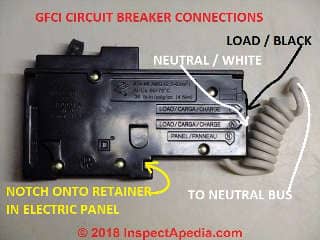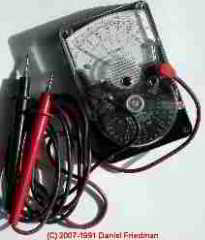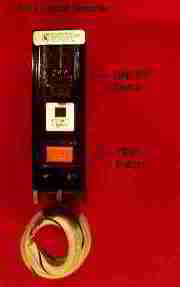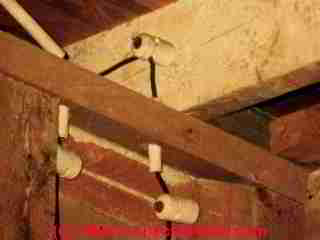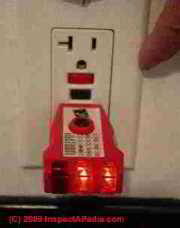 GFCI & AFCI Wiring, Testing, & Safety
GFCI & AFCI Wiring, Testing, & Safety
Common installation defects, inspection, testing
- POST a QUESTION or COMMENT about how to inspect the operating safety & condition of arc fault circuit interrupters and ground fault circuit interrupters
How to inspect AFCIs and GFCIs:
This article series discusses safety procedures for the electrical inspector, home inspector, or other professionals while examining GFCIs and AFCIs. Safe electrical inspection procedures and safe use of volt meters, DMMs, multimeters, and similar electrical test equipment is discussed at the end of the article.
InspectAPedia tolerates no conflicts of interest. We have no relationship with advertisers, products, or services discussed at this website.
- Daniel Friedman, Publisher/Editor/Author - See WHO ARE WE?
Wiring, Inspecting &Testing Electrical Receptacles or "outlets" and GFCI-Protected Receptacles
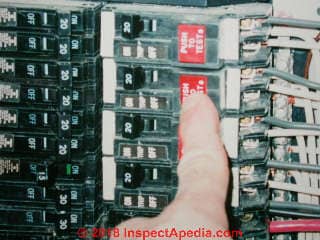 A GFCI or "Ground Fault Circuit Interrupter" is a device, either as a circuit breaker or as an electrical receptacle, that protects against electric shock by detecting a "fault" or "short" to ground (such as through your arm to earth). When such a ground fault is detected the device quickly interrupts electrical power.
A GFCI or "Ground Fault Circuit Interrupter" is a device, either as a circuit breaker or as an electrical receptacle, that protects against electric shock by detecting a "fault" or "short" to ground (such as through your arm to earth). When such a ground fault is detected the device quickly interrupts electrical power.
Building codes require GFCI protection in areas where the shock risk is particularly high such as at wet or damp locations including basements, garages, kitchens, and bathrooms.
Here we discuss:
How do we wire-up a GFCI receptacle? Below we provide GFCI wiring instructions for all of the major GFCI device manufacturers. We include a link to separate AFCI wiring procedures.
How should we test a ground fault circuit interrupter or arc fault circuit interruptor that is already installed in a building?
Do the push-button tests form a complete test? What wiring errors will be disclosed or missed by the usual test procedures for these devices?
Here we provide a Guide to Installing, Wiring ,Inspecting and Testing Electrical Receptacles or "outlets" and GFCI-Protected Receptacles.
Safety considerations during the inspection or test of GFCIs - ground fault circuit interrupters.
Safety considerations during the inspection or test of AFCIs - arc fault circuit interrupters.
Electrical Inspection procedures for the inspection of GFCIs and AFCIs for home inspectors & electrical inspectors.
Question: How do I hook up GFCI breaker on to phase using a common one, neutral?
[Click to enlarge any image]
On 2020-11-19 by Richard
How do I hook up GFCI breaker on to phase using a common one, neutral
This Q&A were posted originally
at ELECTRICAL INSPECTION, DIAGNOSIS, REPAIR - home.
Moderator reply: - how to wire a GFCI receptacle - shared neutral may NOT be ok on an AFCI and possibly on some GFCIs
On 2020-11-19 by (mod)
Richard,
Perhaps I'm misunderstanding something in your question, but in essence
when wiring a GFCI circuit breaker in the electrical panel, the circuit neutral wrie connects to a terminal right on the GFCI receptacle and an integral factory-connected neutral wire in turn connects the GFCI circuit breaker to the neutral bus in the electrical panel.
Wiring electrical receptacles is detailed
at OUTLET, HOW TO INSTALL guide for home owners & home inspectors - it's easy but important details make the difference between a safe installation of an electrical receptacle and one that is both dangerous and illegal.
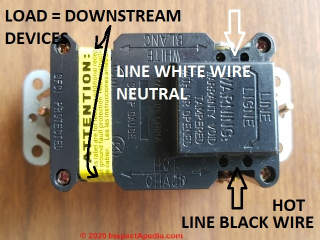 Basic connection notes for GFCI receptacles: the hot wire (black) connects to the brass colored screw labeled HOT and LINE and the netural wire (white) connects to the silver colored screw labeled NEUTRAL and LINE or "WHITE".
Basic connection notes for GFCI receptacles: the hot wire (black) connects to the brass colored screw labeled HOT and LINE and the netural wire (white) connects to the silver colored screw labeled NEUTRAL and LINE or "WHITE".
except that it is particularly critical to wire the supply hot and neutral wires to the LINE terminals on the GFCI - else the device cannot be fully-tested for safe operation.
As we show above, mixing up line and load terminal wiring on GFCIs is such a common mistake that many GFCI receptacles now on the market are sold with a yellow tape covering over the "LOAD" terminals to try to force the installer to connect power to the proper LINE terminals.
See below on this page the details about GFCI Ground Fault Circuit Interrupter & AFCI Arc-Fault Detector Defects & Testing procedures and it will be evident why mixing up the terminals is a problem.
AFCI / GFCI Circuit Breaker or GFCI Receptacle Wiring Instruction Manuals
Watch out: If you are not trained in safe, proper, electrical work you could be shocked or killed; in all events, read and follow the wiring instructions provided with the specific brand and model of GFCI device being installed as those may differ from the GFCI installation instructions provided here.
When reviewing this list of GFCI and AFCI wiring instructions, note in the PDF names that some of these pertain to circuit breakers while others are for installing a GFCI receptacle.
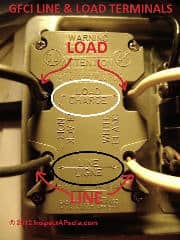 Below we show typical wiring connections at a GFCI receptacle when it is also being used to protect additional daisy-chained electrical receptacles wired "downstream" on the "load" side of the GFCI itself.
Below we show typical wiring connections at a GFCI receptacle when it is also being used to protect additional daisy-chained electrical receptacles wired "downstream" on the "load" side of the GFCI itself.
Watch out: using a shared neutral will cause [at least some ] AFCIs to trip when something is plugged-in to other receptacles on the shared-neutral circuit.
- AFCI - HOW TO INSTALL & TEST AFCIs - separate web article with instructions for wiring AFCIs arc fault circuit interrupters
- Cable Matters, 15A GFCI WR & TR INSTALLATION INSTRUCTIONS [PDF] Cable Matters, Email: support@cablematters.com retrieved 2020/11/20 original source: https://www.cablematters.com/images/ Product/files/400046/Manual/400046 15A GFCI WR &% TR Receptacle Installation Instructions.pdf
- Carling Technologies, PB-SERIES GFCI BREAKER INSTRUCTION BULLETIN [PDF]
- Eaton, INSTALLING A COMBINATION AFCI / GFCI CIRCUIT BREAKER [PDF] (2011) Important Safety Instructions for Installing Circuit Breaker Branch/Feeder 120/240 2-Pole Arc Fault Circuit Interrupter (AFCI) and Ground Fault Circuit Interrupter (GFCI), Eaton Cutler Hammer, Eaton Corporation Electrical Sector 1111 Superior Ave.Cleveland, OH 44114 United States 877-ETN-CARE (877-386-2273) Eaton.com retrieved 2020/11/22 original source: http://m.eaton.com/ecm/groups/public/ @pub/@electrical/documents/content/pub-49748.pdf
Excerpts: What is an Arc Fault Breaker and GFCI?It is a new type of circuit breaker with additional circuit protection, which mitigates the effects of an arcing fault, and also provides personnel ground fault protection.
a. Connect the coiled white “pigtail” wire from the circuit breaker to the panel or enclosure neutral bus terminal & secure tightly.
b. Connect the white (neutral) load wire to the terminal side of the circuit breaker identified with a white mark.
c. Connect the black (hot) load wire to a circuit breaker terminal marked “LOAD”.
d. Connect the red (hot) load wire to the other circuit breaker terminal marked “LOAD”. - Eaton, INSTALLING & TESTING a GFCI RECEPTACLE [PDF] Eaton, Cutler Hammer, retrieved 2020/11/20 original source: https://www.eaton.com/content/dam/ eaton/products/wiring-devices-and-connectivity/ wiring-devices/gfci-receptacles/ installing-testing-gfci-instruction-sheet.pdf
Excerpt: Do not install the GFCI receptacle in an electrical box containing (a) more than 4 wires (not including the grounding wires) or (b) cables with more than two wires (not including the grounding wire). - Eaton (Smith, David), Ground-Fault Circuit Interrupter (GFCI) Protection / Installation Tips and NEC-2020 Updates [PDF] retrieved 2020/11/22 original source: https://eatoncertified.com/sites/default/files/2020-02/P10-14_Smith_David.pdf
- Hubbell, GFCI INSTALLATION & TESTING MANUAL [PDF] (2016) Wiring Device-Kellems Hubbell Incorporated (Delaware)Shelton, CT 064841 USA, Tel: 800-288-6000 Website: www.hubbell-wiring.com retrieved 2020/11/22 original source: https://hubbellcdn.com/installationmanuals /WIRING_PD2082_INSTALLINST.pdf
- Hubbell, INSTALLING & TESTING an OUTLET BRANCH CIRCUIT AFCI/GFCI [PDF] (2016) Op. Cit., retrieved 2020/11/22 original source: https://hubbellcdn.com/installationmanuals/WIRING_PD2750_INSTALLINST.pdf
Excerpts: An Outlet Branch Circuit AFCI/GFCI is different from conventional receptacles. It is intended to provide protection to branch circuit wiring, cord sets, and power-supply cords connected to it against the unwanted affects of arcing, as well as protect against ground faults. In the event of an arc or ground fault, an AFCI/GFCI will trip and quickly stop the flow of electricity to mitigate the efects of the arcing that poses a fire risk, as well as providing protection against serious injury.
Definition of an arcing and grounding fault:
An arcing fault is an unintentional arcing condition in a circuit. Arcing occurs as a normal condition in some motors or when a switch opens.
An example of unintentional arcing would be arcing that occurs due to severed power-supply cord conductors. A ground fault will allow electricity to deviate from it's normal safe path to reach the ground. A defective appliance can cause a ground fault.An Outlet Branch AFCI/GFCI does not protect against circuit overloads, short-circuits or against shock hazards.
The Outlet Branch Circuit Type AFCI/GFCI must be placed as the first outlet in the circuit. - LeGrand, GFCI INSTALLATION & TESTING INSTRUCTIONS [PDF] Pass & Semour LeGrand, PO Box 4822, Syaracuse NY 1322`1 USA, Tel: 800-223-4185, retrieved 2020/11/22, original source: https://media.distributordatasolutions.com/ Legrand/v2/files/ File_8279_GFCI_ReceptaclePDF_%28109_09kb%29.pdf
- Leviton, INSTALLING & TESTING a GFCI RECEPTACLE [PDF], Leviton, Technical Assistance Call:1-800-824-3005 (U.S.A. Only)1 800 405-5320 (Canada Only) www.leviton.co retrieved 2020/11/20, original source: https://www.leviton.com/en/ docs/LC_MO_PDF_EL_7299_INSTRUCTION.pdf
- Leviton, INSTALLING & TESTING a GFCI RECEPTCLE WITH SWITCH [PDF] (2017) Instructions for installing a GFCI receptacle that will be powered through a switch.
- Meiji, INSTALLING & TESTING a GFCI RECEPTACLE [PDF] Meiji Electric, Phillipines, Website: https://meijielectric.ph retrieved 2020/11/22, original source: https://meijielectric-seohacker.netdna-ssl.com/shop/wp-content/uploads/2019/08/GFCI-MANUAL.pdf
- Siemens, CIRCUIT BREAKER & GROUND FAULT CIRCUIT INTERRUPTER Data Sheet [PDF] & wiring diagram, (2008) Siemens Energy & Automation, Inc. 3333 Old Milton Parkway Alpharetta, GA 30005 USA Tel: 1-800-964-4114 Email: info.sea@siemens.com Website: www.sea.siemens.com/residential
- Siemens GROUND FAULT CIRCUIT INTERRUPTER [CIRCUIT BREAKER] Spec Sheet Class A 5mA [PDF] (2017), Siemens Industry, Inc.5400 Triangle Parkway, Norcross, GA 30092 USA 1-800-241-4453 info.us@siemens.com
Excerpts:
Resists false tripping (shielded to prevent RF interference)
Note: A load neutral is not required on the circuit. However, the white line neutral (pigtail) must be connected to the panel neutral for the device to function. - U.S. CPSC, GFCI FACT SHEET [PDF] U.S. Consumer Product Safety Commission Bethesda, MD20814 (800) 638-2772 www.cpsc.gov www.recalls.gov
Excerpts:
A GFCI constantly monitors current flowing through a circuit. If the current flowing into the circuit differs by a very small amount (as little as 0.006 amperes) from the returning current, the GFCI interrupts power faster than a blink of an eye to prevent a lethal dose of electricity. GFCIs are designed to operate before the electricity can affect your heartbeat.
A GFCI works even on two-slot receptacles.
Here's an example: A bare wire inside an appliance touches its metal case. The case is then charged with electricity.
If you touch the appliance with one hand while another part of your body is touching a grounded metal object, such as a water faucet, you will get shocked. If the appliance is plugged into an outlet protected by a GFCI, the power will be shut off before a fatal shock can occur.
The circuits that require GFCI protection are designated by the National Electrical Code (NEC).
The NEC typically only applies to new construction/major renovations. The coverage of GFCI protection has gradually increased over the years.
NEC GFCI requirements (and effective date):
Underwater pool lighting (since 1968)
Receptacles:
Outdoors (since 1973)
Bathrooms (since 1975)
Garages (since 1978)
Kitchens (since 1987)
Crawl spaces and unfinished basements (since 1990)
Wet bar sinks (since 1993)
Laundry and utility sinks (since 2005)
Also note that none of the GFCI receptacle wiring instructions provided above mention a shared neutral wire at all in their instructions, though nuisance tripping is occasionally cited.
For this reason, at least some AFCIs currently (2020) sold in North America typcially are provided with instructions right on the package saying "NOT FOR USE ON SHARED NEUTRAL CIRCUITS".
Details are at NUISANCE TRIPPING of AFCIs
For instructions on how to wire or connect an AFCI device
see HOW TO INSTALL & TEST AFCIs
AFCI & GFCI Testing & Inspection Standards
These electrical inspection suggestions are not a complete inventory of all electrical safety procedures nor of all electrical components that should be inspected; these notes focus on identification of conditions that may present special electrical hazards for the electrical inspector.
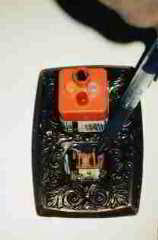 8.1.F. [The inspector shall observe] the polarity and grounding of
all receptacles within six feet of interior plumbing fixtures, and
all receptacles in the garage or carport, and on the exterior of inspected
structures
8.1.F. [The inspector shall observe] the polarity and grounding of
all receptacles within six feet of interior plumbing fixtures, and
all receptacles in the garage or carport, and on the exterior of inspected
structures
Testing is commonly performed using one of a variety of electrical testers. First perform the visual inspection for overheating, looseness, arcing as noted above for switches. If a device is quite loose we do not test further but report it as a required repair. [See "Electrical Receptacles" in this issue.]
8.1.G. [The inspector shall observe] the operation of Ground Fault Circuit Interrupters.
While manual operation of these devices using their internal test button is possible, experience and information about the construction and operation of these devices and the circuits which they serve suggest that testing using GFI-test equipment adds additional information and will find defects not disclosed by manual operation. See "GFCI's" in the original issue of the ASHI Technical Journal.
Electrical "outlet" receptacle testers like the ones shown in these two photos are used by most home inspectors to check for proper wiring at electrical receptacles as well as to check the function of GFCI's.
An electrical receptacle which has been wired 'downstream' from a GFCI or AFCI will be protected by that device provided that the wiring has been connected properly.
We find often that these devices were not wired correctly. For example, reversing the "line" and "load" wiring when installing a GFCI will prevent it from functioning properly even though the installer may test it and think it's fine.
We provide details about using receptacle testers
Requirements for Regular GFCI Testing in the Workplace and in Private Residences
Question: how often should a GFCI be tested in the workplace? Should tests be documented?
2018/07/27 craig said:
How often are CGFIs to be inspected on a commercial site? Is documentation mandatory?
Reply: workplace GFCI Testing Requirements: test monthly, keep a test log
OSHA 1926.404, Wiring design and protection addresses electrical wiring and equipment, and 1926.404(b)(i) requires the use of GFCI.
1926.404(b)(1)(i)
General. The employer shall use either ground fault circuit interrupters as specified in paragraph (b)(1)(ii) of this section or an assured equipment grounding conductor program as specified in paragraph (b)(1)(iii) of this section to protect employees on construction sites. These requirements are in addition to any other requirements for equipment grounding conductors. - Source: OSHA Standards 29 CFR K Electrical, 1926.404 Wiring Design and Protection [PDF] retrieved 2018/07/267, original source: https://www.osha.gov/pls/oshaweb/owadisp.show_document?p_table=STANDARDS&p_id=10705
In interpreting 1926.404 in the workplace OSHA has commented on GFCI test protocols for the workplace as follows:
Section 1926.404(b)(1) does not require GFCIs to be tested.
However, 1926.20(b)(2) does require the frequent and regular inspections of equipment. The instructions included with the devices indicate that they should be tested monthly.
If an employer can demonstrate, for example, by means of logs or procedures, that he or she tests GFCIs monthly and promptly replaces those found defective, then a serious citation may not be appropriate for defective GFCIs found upon inspection, provided the faulty devices are replaced promptly.
OSHA was referring to U.S. Regulations Standards-29-CR, Part 1926, Safety and Health Requirements for Construction, that includes this provision:
1926.20(b)(2) Such programs shall provide for frequent and regular inspections of the job sites, materials, and equipment to be made by competent persons designated by the employers. - Source: OSHA Standards 29 CFR 1926 C General Safety and Health Provisions [PDF] retrieved 2018/07/27, original source: https://www.osha.gov/pls/oshaweb/owadisp.show_document?p_table=STANDARDS&p_id=10606
Read details
at GFCI WORKPLACE TEST REQUIREMENTS OSHA - retrieved 2018/07.27, original source: www.osha.gov/laws-regs/standardinterpretations/1992-02-10
Note: some GFCI devices such as Pass & Semour's Legrand GFCI conducts automatic self-testing and will self-disable if a fault is detected. Details are in the Legrand instructions found at our collection of all GFCI manufacturer's installation manuals
at GFCI INSTRUCTION & TESTING INSTRUCTIONS
Watch out: as we explain
at GFCI TESTING on UN-GROUNDED CIRCUITS (e.g. Knob & Tube) using the integral TEST button on a GFCI is not a complete nor completely-reliable test and will not address all GFCI installations & conditions.
Residential GFCI Testing Requirements: test monthly
In residential properties there is no direct statutory requirement for GFCI testing, though the manufacturer's instructions should be followed, such as "test monthly".
However a careful reading of the U.S. NEC Article 110 requires instructions from the product manufacturer to be followed. That should be interpreted as a code requirement for monthly testing of GFCIs in residential properties as well.
Really? Yes. However in my [DF] experience, few if any homeowners regularly test GFCI devices in their homes. I and other inspectors have found GFCI devices that have never worked properly since original installation, having been improperly wired at that time.
U.S. National Electrical Code NEC Article 110.3 (B) requires GFCI testing - excerpt:
110.3 Examination, Identification, Installation, and Use of Equipment
...
(B) Installation and Use.
Equipment must be installed and used in accordance with any instructions included in the listing or labeling requirements.
Note: In the U.S. NEC, article 110 applies generally to electrical conductors and electrical equipment all electrical installations.
Example of a Manufacturer's Instruction for testing GFCIs
Press the TEST button (then RESET button) every month to assure proper operation.
If the Status Indicator Light does not turn Green when the RESET button is depressed and then released, or the GFCI cannot be reset, it must be replaced.
- Source: Leviton, GFCI INSTALLATION & TEST PROCEDURES [PDF], retrieved 2018/07/27, original source: https://www.leviton.com/en/docs/guidelight.pdf
Safe Use of Electrical Test Equipment: DMMs & VOMs
The following example of electrical inspection limitations & safety for home inspectors is excerpted from an ASHI standard:
8.3 During an electrical system inspection the inspector is NOT required to
8.3.A. insert any tool, probe, or testing device inside the panels
See SAFETY for ELECTRICAL INSPECTORS for details
How to Test digital volt meter DMM or Volt Ohm Meter VOM meter condition
Safe Use of Electrical Test Equipment: DMMs & VOMs
8.3 During an electrical system inspection the inspector is NOT required to
8.3.A. insert any tool, probe, or testing device inside the panels
See SAFETY for ELECTRICAL INSPECTORS for details
In some circumstances ASHI inspectors may elect to make current and voltage measurements. For inspectors who elect to use these tools, make sure that the tools themselves do not become a source of damage, or injury.
Use only DMM's (digital multi meters) or VOMs (volt-ohm meters, the analog predecessors to DMMs) designed for high energy measurements.
Details about safe use of VOMs and DMMs are provided
These electrical inspection suggestions are not a complete inventory of all electrical components that should be inspected; these notes focus on identification of conditions that may present special electrical hazards for the electrical inspector.
Using a DMM or VOM to Check for Current
A simple volt ohm meter volt-ohmeter (VOM) such as the TriplettTM 310 or our little mini digital multimeter (DMM) shown at left can be used to test for unexpected and unsafe voltage at a component.
- Set the VOM in the highest AC-voltage range.
- One probe is used to contact the surface of the electric panel (or any component to be examined)
- The other probe is touched to a reliable ground source, or in the example shown, to the neutral side of the circuit.
NOTE: Once having tested at the highest voltage range, greater accuracy may be obtained by choosing more sensitive ranges which permit readings to be taken in the upper portion of the scale. Disconnect the test probes (or shut off the voltage source) before changing the voltage range setting on the VOM.
Details on safe use of DMM's and VOMs are
For example, if the meter indicates more than 1or 2 volts between a service panel cover and ground, there's a safety problem. Most low-cost analog-type meters such as the one described provide additional ranges used to read lower voltages with more sensitivity.
Some VOM models provide alligator clips for the ends of the test probes. These clips permit measuring high voltage without handling the probes. Always shut off the power before connecting the alligator clips.
Inspecting Arc Fault Circuit Interrupters AFCIs - Safe Procedures
AFCIs: The requirement to inspect and test AFCIs is already in some regulations for home inspectors. It seems likely that remaining home inspection associations and state or provincial inspection standards-writers will soon update their electrical inspection standards section to address the new requirement for AFCI's.
See AFCIs ARC FAULT CIRCUIT INTERRUPTERS for details of the electrical code changes regarding the requirement for arc fault interrupters in homes, the effectiveness of AFCIs, and nuisance tripping problems with AFCIs.
AFCIs can be properly tested only by using the test button on the device itself. External tool tests are incomplete and therefore unreliable.
There have been some recalled AFCI devices that might not work reliably. If you had the bad luck to try your amateur test on one of these, the results could be a disaster.
See this Federal Pioneer AFCI RECALL issued by Schneider Electric.
ELECTRICAL INSPECTOR SAFETY PROCEDURES describes important basic safety procedures, clothing, and equipment for home inspectors and electrical inspectors.
Testing GFCIs on Un-Grounded Knob and Tube Electrical Circuits
A ground fault circuit interrupter can provide shock protection for an electrical circuit that has no ground present, such as a knob and tube electrical circuit.
The GFCI device will still work if it detects a current leak to ground - say if an occupant drops their hair dryer into the sink (which is full of water grounded via the building plumbing system).
But can you test the GFCI protection feature of a GFCI receptacle installed on a knob and tube circuit
There are two "answers":
- No: the GFCI test device or internal GFCI test exercised by the test button depends on being able to produce a small internal current leak to ground. Since there is no electrical ground wire present, the test feature won't work.
- Yes, sort-of: you could rig your own test of a GFCI device on a knob and tube or other un-grounded circuit by making a connection from the hot lead of the receptacle to a known ground such as a water pipe or radiator. We've demonstrated this procedure using a test instrument as well as a bare wire.
Watch out: DO NOT DO THIS unless you are specially trained and equipped to do so. It is dangerous for various reasons including the chance that you or a bystander will be killed by electric shock.
There have been some recalled GFCI devices that would not work reliably. If you had the bad luck to try your amateur test on one of these, the results could be a disaster.
See SQUARE-D COUNTERFEIT BREAKER RECALL.
See details of 2-wire, un-grounded electrical circuits such as un-grounded receptacles or "outlets"
at ELECTRICAL CONNECTION for 2-WIRE RECEPTACLE CIRCUIT
2008 Code Changes Affecting Ground Fault Circuit Interrupters GFCI's
Please see details now moved to GFCI PROTECTION, GFCI CODES
General Safety Suggestions for Electrical Inspectors
Pay attention, look carefully, move slowly before opening or exploring electrical equipment. Learn to recognize indications of a problem, such as but not limited to the examples in this article.
Do not assume anything when performing dangerous tasks such as inspecting electrical equipment.
- Do not assume that electrical power is "off" without confirming that using proper test equipment and methods
- Do not assume that system grounding is complete and correct
- Do not assume that all circuit breakers and GFCI's and AFCI's will work
- Do not assume that bystanders or clients won't move suddenly into the path of danger, or push you into it.
Do not touch live wires or connections. Watch your hands and other body parts. Handling live electrical wires without special training and equipment is highly questionable and often fatal.
December 12, 1988 - Madison, WI - Michael E. Hammes, 26, died in an apparent electrocution while working in Madison. Hammes had been hired by CUNA Mutual Insurance Society to change ballasts on fluorescent lights. Authorities said he was replacing a fixture in a fourth floor bathroom while standing on a stepladder when he slumped to the floor.
Hammes apparently was electrocuted when he touched live wire with one hand and a metal partition with his body or other hand, according to Dana County Coroner Ray Wosepka.
Hammes was a first-year electronics student. Wosepka said his investigation showed the light fixture had been properly wired. Hammes apparently replaced a ballast, a [transformer] that controls the electrical flow to the light bulbs, and was attaching the live wire when it electrocuted him, Wosepka said. -- Ibid.
If in your opinion unsafe conditions exist at a property you are inspecting you should notify all parties concerned, including building occupants/management/owners, realtors involved, and other appropriate authorities.
December 18, 1988 - Smyrna, GA - A Smyrna family's troubles with a faulty circuit breaker in their mobile home ended in tragedy when a fire broke out and killed 18-year-old Jeffrey Scott Auton. Auton's family, experiencing problems with the main circuit breaker, went to a home products store to buy a new one for their trailer, said Fire Investigator David Herndon.
The store did not have a circuit breaker to fit the family's needs and a new one had to be ordered. .... Herndon said the fire was started when the circuit breaker shut down completely as three space heaters were running.
The family had
a history of problems with the breaker, particularly from a load put
on it by a large heating unit. Herndon stated that after the fire
there was not a trace left of the circuit breaker; it was completely
gone from
For example, what if the case above had happened the day after the property described had been examined by an ASHI inspector?
Were there perhaps clues which telegraph a developing problem? What about anecdotal reports from the occupants of recurrent breaker tripping, visible signs of overheating in the panel, widespread and unusual use of electric heaters, or evidence of work in the panel by untrained people?
These risks to occupants are also a hazard to the inspector on several bases.
Protect yourself and your client from injury using but not limited to the suggestions we provide here and just below.
Electrical Inspection Safety Suggestions from Rex Cauldwell, a Master Electrician
OPINION-RC: "As a master electrician, here is how I teach opening a service panel in my seminars: "The lucky 7""
- Eye protection: Wear safety glasses--electrical panels have been know to explode upon opening.
- Insulating gloves: Wear rubber dishwashing gloves--panels have been known to become electrically hot as a screw falls when cover is removed.
- Look before touching: Don't approach the panel until you give an overall look of the surrounding area to see if anything looks wrong--such as water on the floor under the panel.
- Avoid Shock Pathways: Don't have any part of your body touching items adjacent to the panel.
- Insulating floor pad: On a concrete or dirt floor, lay down a thick rubber Welcome mat and stand on it as you open the panel (wear rubber-soled shoes).
- Insulating tools: Use insulated handle tools--I use a Milwaukee electric screwdriver.
- Panel Door & Screws: Once door is open (in a Federal Pacific panel (and some other models) beware of falling trim and breakers that pop out), set door aside and don't lose the screws
Further Safety Warning--DF: these are helpful electrical safety suggestions from an experienced electrician. No list of suggestions is incomplete and these presume that they are being followed by an experienced, licensed electrician.
For example, there are almost certainly gloves and/or boots specifically recommended for this application; there are specific safety details to look at and for before touching an electrical panel, and procedures for using electrical test equipment to test or examine a suspect electrical panel.
Recommended books on electrical wiring:
Rex Cauldwell's Wiring A House - available online.
Rex Cauldwell's Safe Home Wiring Projects - available online
Electrical Inspection Follow up and Client Safety
A home inspector or electrical inspector who has reported a very unsafe condition, recommended immediate action, and yet may later learn that occupants of the building were nearly killed by work by an incompetent repairman. [NOTE: Port Jervis, NY, AHS Ctl#4658911, 7/10/90.]
What can be done to reduce the chance of this terrible consequence?
Recommending action on an unsafe condition can convert a pre-existing problem into an immediate catastrophe if the client or owner calls an untrained person to the property or if he attempts a do-it-yourself repair.
Often a referral to local fire inspector, electrical inspector, or utility company can help assure that repairs are prompt, proper, and safe. If you recommend immediate action for an unsafe condition, where possible you should provide some means for the client or building owner to assure that the action which is taken is proper and safe.
Inspectors are properly nervous and reluctant to prescribe the actual repair that is needed at a property - they may not know the detailed repair procedure, or there may be alternative repairs, or their description may prompt an un-trained person to try to do the work.
The Building Owner or Building Manager Needs to Know About Unsafe Conditions that Need Immediate Action
- What kind of trades person, utility worker, or other technician is proper to perform the necessary repair?
- What steps should be taken by the building owner or manager to assure that the repair is proper and safe?
- Is there an independent follow-up authority such as a fire inspector, utility company representative, or building code compliance inspector who should examine the repair?
- Are there well-known and common foul-ups in repair, or local inept repair companies against whom the owner should be warned?
The inspector should inform the appropriate parties both orally and in writing any suspected unsafe conditions.
If an area or component could not be fully inspected, the inspector should explain in writing why she or he did not enter or examine an area or component, and what additional inspections or steps should be taken, as well as the general risks that may be present.
Handling Immediate Threats to Life and Safety at a Building Inspection
If in the inspector's judgment equipment is an immediate threat to life and property, such as a boiler whose flue connection has fallen off, we recommend that dangerous equipment be shut down and the appropriate people notified.
See SHUT DOWN UNSAFE EQUIPMENT. In some cases "appropriate people" includes not only the client and building owner, but also building occupants.
In some instances such as sparking electrical panels, gas leaks, or evidence of a fire, the inspector and everyone else should leave the building immediately and from outside, call the fire department and as appropriate, the gas company, police, or rescue person
...
Reader Comments, Questions & Answers About The Article Above
Below you will find questions and answers previously posted on this page at its page bottom reader comment box.
Reader Q&A - also see RECOMMENDED ARTICLES & FAQs
On 2023-12-20 by InspectApedia Publisher
@mike,
Thank you for your very nice note.
Indeed we've worked hard on this material for many years, so we're especially grateful when readers find it trusted and helpful
Your questions and discussion are also helpful to us and to others, and we always welcome also any content criticism or suggestions you might have.
On 2023-12-19 by mike
@InspectApedia-911,
I don't have GFCI (I know I should...maybe I will replace it), just regular old outlet there near the counter. But what you say make perfect sense.
Some years ago you helped me with my well pump and pressure switch issue. Always appreciate your quick replies. Don't know how you do it but more power to you. Thanks a bunch!!
Just saw your added comment about why I posted this question here. Your site is so very huge, I just did not know where to go. I will be more careful in the future.
On 2023-12-19 by InspectApedia-911 (mod) - Why would the outlet by the fridge need all those wires?
@mike,
Most likely the electrical circuit feeds the refrigerator first and then continues onward to power the GFCI electrical receptacle that you.
If so, at the fridge two wires bring power in and two more carry it onwards to the GFCI.
That sequence prevents a tripped GFCI receptacle from also powering off your refrigerator.
Continuing...
Please help us out by telling me why this is posted on our contact page instead of on a related topic page.
We don't mind moving this to a relevant page where it'll be found by readers who have similar questions but we're trying to understand if we have something wrong on our website design that causes you to post here instead of there.
Thanks.
On 2023-12-19 by mike
My kitchen has a 20amp outlet with single hot/neutral wires inside at the counter level, and another outlet for the fridge with 2 hot and 2 neutral wires inside.
These two outlets share a 20 amp circuit breaker, as everything that is connected on these two outlests turn off when I flick off the 20 amp breaker.
Why would the outlet by the fridge need all those wires? The house was built in the 1950s.
Reader Comment: reports defective GFCI Test Button in New Device
(Aug 6, 2014) Dick N said:
In regarding your statement at BACK-WIRED ELECTRICAL DEVICES
"For example, if you connect the incoming "hot" wire and neutral wire to the "load" terminals on a GFCI, and if you connect wires leading to downstream electrical receptacles to the "line" terminals (these are the incorrect connections), then pushing the test button on the GFCI will not activate that device's internal trip mechanism."
I recently picked up a used Leviton "spec grade" (stamped thus on the mounting strap) GFCI outlet which was stuck in the "tripped" condition and could not be reset. I partly disassembled the device and discovered that the TEST button doesn't test anything except the TEST button and, arguably, verifies that the contacts aren't welded together. It could have at least been designed to move the solenoid plunger, thus verifying that the mechanical linkage works, but alas it doesn't even do that. Ironically, the instruction "TEST MONTHLY" appears on the front.
Henceforth, before buying any GFCI outlet, I will push the TEST button in the store before I pay for it. If it trips with no line power, it obviously doesn't test the circuitry.
After repair, which involved bending a couple of springs, it works as it appears designed to work - trips upon ground fault or TEST button, and the RESET button resets it.
This device breaks neutral also. Is that really necessary?
This comment was posted originally
at BACK-WIRED ELECTRICAL DEVICES
Reply:
Dick,
We discuss the "test button" on GFCI devices [in the article above]
In my opinion a GFCI should break both hot and neutral wires. a dangerous short could occur on either of those wires, and in ways you may not anticipate. Consider a shared-neutral: cutting off power at a device by opening the "hot" wire won't protect someone touching a neutral wire that is still carrying current because something is plugged-in and running at a different receptacle that shares the same neutral wire.
See MULTI-WIRE CIRCUITS for details.
Adding complexity to debugging GFCI wiring, my ex-brother-in-law Matt W., who had electrical wiring experience only as a theater electrician, over-tightened the strain relief connectors on the BX wiring thought a NY City apartment.
On turning on power all the hot-to-ground shorts were found right away. But it took more sleuthing to come up with continued GFCI tripping that we traced to strain reliefs that had cut into the neutral wires. There were shorts hot to ground, hot to neutral, and neutral to ground.
You are not quite right that the test button does not test anything.
The test button, using an internal circuit in the GFCI device, tests the trip mechanism itself - within the device. But because it's using an internal circuit, that test is incomplete and will not detect some wiring errors nor a missing ground connection.
Pressing a test button on the device when it is not powered is ambiguous.
Keep in mind that the GFCI, working properly, should detect BOTH a short of hot to ground AND a short of hot to neutral. That's why you see it breaking the neutral when tested.
Watch out: I would never rely on a GFCI or AFCI that someone had opened, modified, bent springs, etc. The result may be unreliable, unsafe, risking fire or shock.
...
Continue reading at AFCIs ARC FAULT CIRCUIT INTERRUPTERS or select a topic from the closely-related articles below, or see the complete ARTICLE INDEX.
Or see AFCI GFCI TESTING & SAFETY FAQs - questions & answers about safe testing procedures posted originally on this page.
Or see this
Recommended Articles
- AFCIs vs. GFCIs - what's the difference
- AFCIs ARC FAULT CIRCUIT INTERRUPTERS - home
- AFCI - HOW TO INSTALL & TEST AFCIs - wiring instructions
- ELECTRICAL TOOLS BASIC
- FREEZE-PROOF A BUILDING where we describe GFCI protection on heat tape circuits
- GFCI PROTECTION, GFCI CODES
- GROUND SYSTEM INSPECTION
- SAFETY for ELECTRICAL INSPECTORS
- SUMP PUMP INSPECTION - heat tapes
Suggested citation for this web page
AFCI GFCI WIRING, TESTING & SAFETY at InspectApedia.com - online encyclopedia of building & environmental inspection, testing, diagnosis, repair, & problem prevention advice.
Or see this
INDEX to RELATED ARTICLES: ARTICLE INDEX to ELECTRICAL INSPECTION & TESTING
Or use the SEARCH BOX found below to Ask a Question or Search InspectApedia
Ask a Question or Search InspectApedia
Try the search box just below, or if you prefer, post a question or comment in the Comments box below and we will respond promptly.
Search the InspectApedia website
Note: appearance of your Comment below may be delayed: if your comment contains an image, photograph, web link, or text that looks to the software as if it might be a web link, your posting will appear after it has been approved by a moderator. Apologies for the delay.
Only one image can be added per comment but you can post as many comments, and therefore images, as you like.
You will not receive a notification when a response to your question has been posted.
Please bookmark this page to make it easy for you to check back for our response.
IF above you see "Comment Form is loading comments..." then COMMENT BOX - countable.ca / bawkbox.com IS NOT WORKING.
In any case you are welcome to send an email directly to us at InspectApedia.com at editor@inspectApedia.com
We'll reply to you directly. Please help us help you by noting, in your email, the URL of the InspectApedia page where you wanted to comment.
Citations & References
In addition to any citations in the article above, a full list is available on request.
- Electrical shock injury statistics: www.healthatoz.com - September 2008;
High-tension current generally causes the most serious injuries, although fatal electrocutions may occur with household current (e.g., 110 V in the United States and Canada and 220 V in Europe, Australia, and Asia). Contact with alternating current at 60 cycles per second (the frequency used in most US household and commercial sources of electricity) may cause tetanic skeletal muscle contractions, preventing self-release from the source of the electricity and thereby leading to prolonged exposure. The repetitive frequency of alternating current also increases the likelihood of current flow through the heart during the relative refractory period (the "vulnerable period") of the cardiac cycle. This exposure can precipitate ventricular fibrillation (VF), which is analogous to the R-on-T phenomenon.-- circ.ahajournals.org - September 2008
- "Frequency of Occurrence and Sources of Rust and Corrosion in Electrical Panels," Daniel Friedman, IEEE HOLM Conference, Philadelphia PA, 1992 - see ELECTRIC PANEL RUST for an online version of this article.
- Jim Simmons: Personal communication, J. Simmons to Daniel Friedman, 9/19/2008. Photographs contributed to this website by Jim P. Simmons, Licensed Electrician, 360-705-4225 Mr. Electric, Licensed Master Electrician, Olympia, Washington Contact Jim P. Simmons, Licensed Master Electrician, Mr. Electric, 1320 Dayton Street SE
Olympia, WA 98501, Ph 360-705-4225, Fx 360-705-0130 mrelectricwa@gmail.com - Kenneth Kruger: Original author of the sidebar on testing VOM DMM condition: Kenneth Kruger, R.A., P.E. AIA ASCE, is an ASHI Member and ASHI Director in Cambridge, MA. He provided basis for this article penned by DJ Friedman.
- "How to Use DMM's Safely," Leonard Ogden, CEE News, 888 Seventh Ave., New York, NY 10106, Dec 1990 p.10.
- Dr. Jess Aronstein, consulting engineer, Poughkeepsie NY, 1991 protune@aol.com
- Rex Cauldwell, master electrician and contributor to the Journal of Light ConstructionOn electrical topics
- "Electrical System Inspection Basics," Richard C. Wolcott, ASHI 8th Annual Education Conference, Boston 1985.
- "Simplified Electrical Wiring," Sears, Roebuck and Co., 15705 (F5428) Rev. 4-77 1977 [Lots of sketches of older-type service panels.]
- "How to plan and install electric wiring for homes, farms, garages, shops," Montgomery Ward Co., 83-850.
- "Simplified Electrical Wiring," Sears, Roebuck and Co., 15705 (F5428) Rev. 4-77 1977 [Lots of sketches of older-type service panels.]
- "Home Wiring Inspection," Roswell W. Ard, Rodale's New Shelter, July/August, 1985 p. 35-40.
- "Evaluating Wiring in Older Minnesota Homes," Agricultural Extension Service, University of Minnesota, St. Paul, Minnesota 55108.
- "Electrical Systems," A Training Manual for Home Inspectors, Alfred L. Alk, American Society of Home Inspectors (ASHI), 1987, available from ASHI. [DF NOTE: I do NOT recommend this obsolete publication, though it was cited in the original Journal article as it contains unsafe inaccuracies]
- In addition to citations & references found in this article, see the research citations given at the end of the related articles found at our suggested
CONTINUE READING or RECOMMENDED ARTICLES.
- Carson, Dunlop & Associates Ltd., 120 Carlton Street Suite 407, Toronto ON M5A 4K2. Tel: (416) 964-9415 1-800-268-7070 Email: info@carsondunlop.com. Alan Carson is a past president of ASHI, the American Society of Home Inspectors.
Thanks to Alan Carson and Bob Dunlop, for permission for InspectAPedia to use text excerpts from The HOME REFERENCE BOOK - the Encyclopedia of Homes and to use illustrations from The ILLUSTRATED HOME .
Carson Dunlop Associates provides extensive home inspection education and report writing material. In gratitude we provide links to tsome Carson Dunlop Associates products and services.


